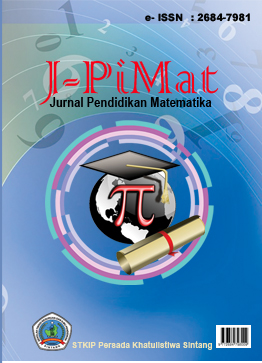Pembelajaran Berbasis Proyek Terhadap Kemampuan Berpikir Kreatif Siswa Pada Materi Bangun Ruang
DOI:
https://doi.org/10.31932/j-pimat.v5i2.2718Abstract
Berpikir kreatif dan kemandirian belajar matematis siswa tergolong belum maksimal digali pada diri siswa dalam pembelajaran dengan fokus utama pada guru. Sehingga diperlukan model pembelajaran yang melibatkan aktivitas berpusat pada siswa. Penelitian ini bertujuan untuk melihat pengaruh model pembelajaran Project Based Learning (PjBL) terhadap kemampuan berpikir kreatif matematis siswa. Penelitian menggunakan metode kuantitatif dengan jenis penelitian quasi eksperimen dan desain penelitian posttest only group design. Populasi yang digunakan adalah seluruh siswa kelas VII SMP Negeri 1 Nisam. Dengan teknik pengambilan sampel purposive sampling maka didapat siswa kelas VIIA sebagai kelas eksperimen dan VIIB sebagai kelas kontrol. Teknik pengumpulan data yang dilakukan adalah pemberian posttest kemampuan berpikir kreatif matematis. Pengujian hipotesis dilakukan dengan menganalisis tes kemampuan berpikir kreatif matematis menggunakan t-tes dengan bantuan software SPSS 25 dengan taraf signifikansi 0,05. Berdasarkan analisis data diperoleh sig. hasil pengujian data kemampuan berpikir kreatif sebesar 0,000. Berdasarkan kriteria uji hipotesis disimpulkan bahwa terdapat pengaruh model pembelajaran Project Based Learning (PjBL) terhadap kemampuan berpikir kreatif matematis siswa pada materi bangun ruang di SMP Negeri 1 Nisam.Downloads
Published
2023-11-01
How to Cite
Hidayat, A. T. (2023). Pembelajaran Berbasis Proyek Terhadap Kemampuan Berpikir Kreatif Siswa Pada Materi Bangun Ruang. J-PiMat : Jurnal Pendidikan Matematika, 5(2), 819–826. https://doi.org/10.31932/j-pimat.v5i2.2718
Issue
Section
Articles
License
The Journal of Mathematics Educational (J-PiMat)Â is an Open Access Journal. The authors who publish the manuscript in this journal agree to the following terms:
JEES is licensed under a Creative Commons Attribution 4.0 International License. This permits anyone to copy, redistribute, remix, transmit and adapt the work provided the original work and source is appropriately cited.
This means:
- Under the CC-BY license, authors retain ownership of the copyright for their article, but authors grant others permission to use the content of publications in J-PiMat Journal in whole or in part provided that the original work is properly cited. Users (redistributors) of J-PiMat are required to cite the original source, including the author's names, J-PiMat as the initial source of publication, year of publication, volume number, issue, and Digital Object Identifier (DOI);
- Authors grant J-PiMat the right of first publication. Although authors remain the copyright owner.






